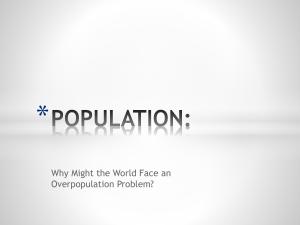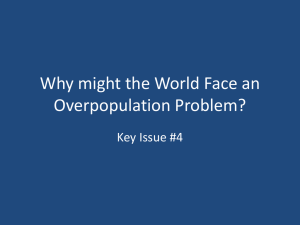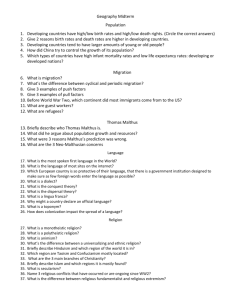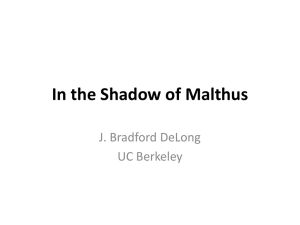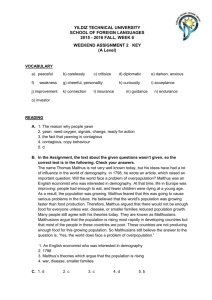Overpopulation
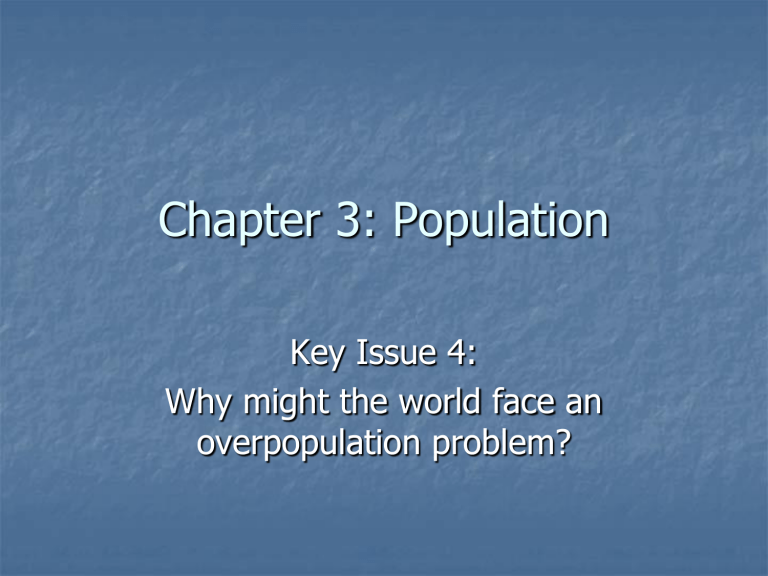
Chapter 3: Population
Key Issue 4:
Why might the world face an overpopulation problem?
Malthus
Thomas Malthus (1766-1834)
Essay on the Principle of
Population 1798
Consequences:
Population growth would press against available resources
Disease, famine, war would ensue
Population Growth vs Food
Supply
Population growing too fast for food supply
Pop grows geometrically while population growths arithmetically
Example:
Today- 1 person, 1 unit of food
25 years- 2 people, 2 u.o.f.
50 years- 4 people, 3 u.o.f.
75 years- 8 people, 4 u.o.f
Neo-Malthusians
Two problems even worse than in Malthus’ time
Malthus failed to anticipate that poor countries would have rapid pop growth
Resource gap wider than
Malthus assumed
World pop is outstripping resources
Not just food production
Malthus’s Critics
Unrealistically pessimistic
Malthus based theory on idea that supply of resources is fixed, not expanding
Larger pop can stimulate economic growth
Economic development
Poverty, hunger, etc. caused by lack of economic development with unjust social and economic institutions NOT population growth
Malthus’s arithmetic – capitalism (Engels’ Theory)
Too few people can retard the economy just as too many
Resources should be shared equally
More people = more power?
Political leaders in Africa
More pop = more men in army
Reality
Conditions last halfcentury do not support Malthus theory
Food production has increased dramatically
Green revolution
Wheat production X2
Slowed recently?
Declining Birth Rates
Food production increased more than Malthus predicted
Malthus’s model expected that the pop would quadruple but it didn’t
Rate of Natural Increase is decreasing
More deaths or less births
Exception LDCs
Reasons for declining birth rate
Economic Development:
lowering birth rates improve economic conditions
women more likely to attend school increased knowledge of family planning better health care programs
Distribution of Contraceptives
World can’t wait for economic improvement
LDC’s demand is greater than supply
Still is occurring
Bangladesh, Colombia,
Morocco, Thailand
Has not spread to Africa
Reflects the status of women
Contraceptives a religious issue and political issue
India
Became independent
1947
Began a population planning program in 1950’s
Census in 1960’s reveals extreme growth
During the 1970’s the
Indian government began a policy of forced sterilization of any man with three or more children.
3.7 million were sterilized
Public outcry and opposition
Today sterilization is making a comeback
Propaganda now encouraging “small” families
•
•
India gendercide
China’s One Child Policy
•
Forced abortion
World Health Threats
Epidemiologic transition:
focuses on distinctive causes of death in each stage of the demographic transition
Epidemiology:
Branch of medical science concerned with the incidence, distribution, and control of diseases that affect large numbers of people
Epidemiologic Transition Stage 1 & 2
Stage 1: Pestilence and famine
Infectious and parasitic diseases were principal causes of human death
Malthus called these
“natural checks”
Example:
Black Plague
Stage 2: Receding
Pandemics
Pandemic is a disease that occurs over a wide and affects a very high proportion of the population
Industrial revolution helped slow spread of disease
Not immediately
Example:
Cholera
Black Plague
Bubonic plague
Worst stage 1 case
From Kyrgyzstan brought by Tatar army
Spread from urban areas to rural areas
Western Europe 1348
Northern Europe 1349
Wiped out entire villages and families
United States- 25 million died
China – 13 million died
Cholera
Stage 2
Pandemic: disease occurs over a wide geographic area
Poor people crowded into industrial cities
½ million in NYC died in 1832
1/8 th population of Cairo 1831
Geographic Models the key to understanding
Edwin Chadwick (1800-1890)
Residents in poorer neighborhoods had higher incidences of Cholera
Dr. John Snow (1813-1858)
Mapped distribution of deaths in London
Not a cause of sinful behavior
Water pumps the cause
Stages 3 & 4
Stage 3: Degenerative and human-created diseases
characterized by a decrease in deaths from infectious deaths and chronic disorders associated with aging
Cardiovascular disease cancer
Decline in infectious diseases has been sharp in stage 3 countries
Recently LDCs recently moved from stage 2 to stage 3
Effective vaccines
Stage 4: delayed degenerative diseases
Cardiovascular disease and cancer still linger but life expectancy extended
Improved healthcare
Improving behaviors as well
Better diet
Reduced use of tobacco, alcohol, and exercise
Stage 5 ????
Stage of reemergence of infectious diseases and parasitic disease
Old and new have emerged
Three reasons:
Evolution
Microbes evolved, changed = resistant
Example: Malaria
Poverty
TB in LDCs
Long, expensive treatment
Improved travel
H1N1

